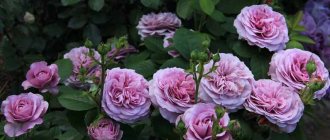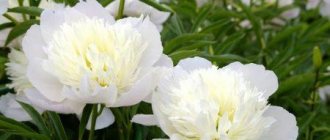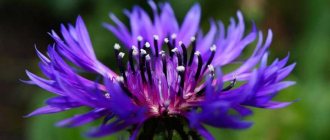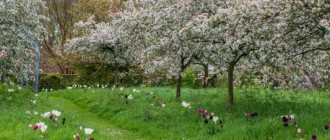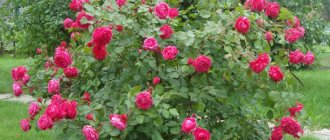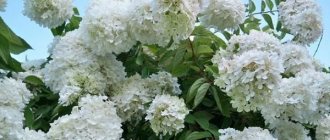Types and classification of winter-hardy roses
There is a modern classification that divides all frost-resistant varieties of roses into 3 groups:
- Absolutely winter-hardy flowers are also in an upright position in winter, withstanding the lowest temperatures and do not require special care;
- winter-hardy roses are also vertically positioned during wintering, but in severe frosts there is a tendency to freeze; average degree of stability do not require shelter in mild winters and freeze only to the level of snow, so they need to be bent.
The most winter-hardy roses - video
The highest frost resistance is present in park roses: winter-hardy varieties are represented by William Shakespeare, Westerland and others. They are ideal for growing in the central zone of the country, in particular in the Moscow region. BEAUTIFUL VARIETIES OF ROSES! Rose Versilia Climbing Rose Caesar Rose Pierre de Ronsard
Artificially bred roses in the form of Canadian hybrids, which are able to survive at temperatures of -45 degrees below zero without damage, can easily compete with them. They are also suitable for the northern regions, the Urals and Siberia.
How to choose roses for growing in Siberia and the Urals
The harsh climate of these regions dictates its own rules for choosing ornamental plants. Winters here are long, spring is late, warm days are rare. Seedlings should be purchased already adapted to such weather conditions. Unpretentious varieties of perennial roses for these regions are considered:
- Residence;
- Stadt rum;
- Popsicle;
- Larissa;
- Fairy;
- Sunny fairy tale;
- Jazz.
For the northwestern regions, it is better to choose creeping ground cover varieties of the following species:
- patios – low-growing, ridged, landscaped;
- floribunda - landscape, flower beds with abundant flowering;
- Canadian - Aisha, Queen of the North, Casanova, Abusta.
The last group is most preferable, since in Canada the climate is the same as in northern Russia. Roses grafted onto mother plants grown in Siberia or the Urals tolerate severe frosts well.
Note! Winter-hardy roses intended for cultivation in harsh climates must be resistant to pests and diseases
Astronomy
One of the most unusual varieties is distinguished by an atypical flower shape that resembles an apple tree. Just five white and pink petals form delicate stars with decorative stamens. Astronomia is a very frost-resistant variety and can be grown as a ground cover.
Photo: ogorod.zelynyjsad.info
Remontant varieties
Remontant varieties differ from traditional hybrids by repeated flowering, but lower growth intensity. The bush reaches a height of about 2 m. The plants have large, beautiful inflorescences and are often frost-resistant.
This is important: How to insulate a rose for the winter
Abraham Darby
A low-growing crop, reaching a height and width of 1.5 m. The flowers are large, heavy, with a diameter of 8-14 cm. To prevent the branches from bending under them, supports are placed on them during the flowering period.
The inflorescences are densely double, soft apricot in color. In cold weather they take on a pink tone. The aroma is very subtle. Flowering continues from spring to autumn almost continuously. The plant has average frost resistance.
Feuewerk
The name fully justifies the color of the buds of this shrub variety. The flowers are semi-double, with wavy petals, and salmon-orange in color. They reach 8 cm in diameter and appear singly on branches. During the season, inflorescences appear several times.
The leaves are light green, glossy. The bush grows 2 m high and 1.3 m wide. It tolerates frost and rain well, so it is widespread in Europe and Russia. The culture is suitable for planting in public places and garden plots.
Frühlingsduft (Spring scent)
A spreading plant, reaching 2 m in height and width. The flowers are large, creamy yellow, up to 8 cm in diameter, collected in clusters of 5 pieces. A strong, refined aroma emanates from the buds. The leaves are light green, darkening closer to autumn.
How and when to feed roses so that they bloom magnificently, read the article
To describe this variety, such characteristics as frost-resistant, moisture-resistant, and almost not susceptible to diseases are quite suitable. Flowering is abundant, begins in early spring and continues until autumn.
Graham Thomas
A popular English variety of park roses. A fast-growing, medium-sized plant, reaching 1.5 m. The flowers are large, double, rich yellow, shaped like peonies.
The crop blooms throughout the summer. When grown in the middle zone, it showed resistance to frost and tolerates rain well. Since the inflorescences are quite heavy, the shoots have to be tied up or supported under them so that the branches do not break off.
Grand Hotel
A spreading powerful bush, reaching 2 m. The buds are red, almost purple, velvety, their diameter is 10 cm. The inflorescences are single, odorless, shimmering in various shades.
Buds appear throughout the summer and until late autumn. When they fade, decorative fruits ripen in their place. Plants are frost-resistant. They are usually planted in groups along a fence or trellis.
Rosa rugosa (wrinkled)
Medium-sized crop with thick gray-green shoots. The stems are covered with numerous thorns. The buds are purple, with a pinkish tint, and emit a clove aroma. Inflorescences appear before autumn, and small fruits ripen in their place.
The rose got its name from the shape of its leaves: they are wrinkled and shiny. The culture is hardy, unpretentious, almost never gets sick, resistant to drought and frost, and takes root well in urban environments. It is planted both singly and to form hedges.
Lichtkönigin Lucia (Light Queen Lucia)
The rose is medium-sized, with reddish-green shoots covered with thorns. Throughout the summer, double yellow inflorescences with a diameter of up to 10 cm appear on it. They are collected in brushes of 5 to 15 pieces.
Flowering is abundant and long lasting. The buds emit a pleasant, persistent aroma. The leaves are large, dark green, shiny. The crop is frost-resistant and is widely used in park plantings.
'Louise Odier
Bush up to 2 m high, with light green shoots. The inflorescences are double, light lilac, with a pink center. The buds are connected in brushes of 5-6 pieces. The plant has a strong aroma. It blooms profusely, the petals can be used for confiture. The variety is resistant to frost and diseases.
Westerland (Western)
A tall crop, reaching a height of 1.5 m, growing in width by 2 m. The main tone of the inflorescences is orange and peach. Depending on the weather, it may appear light yellow and pink tones.
The flowers are semi-double, large, up to 12 cm in diameter. The plant is resistant to rain and cold, flowering continues almost until frost. The variety is disease resistant and unpretentious.
Mimi Eden
One of the most romantic varieties has been actively conquering the gardens of the Moscow region in recent years. The delicate pink center of Mimi Eden turns into greenish outer petals. The buds are collected in large clusters of up to 10 pieces, and the bush itself is low, but very wide, up to 110 cm.
Photo: instagram.com
The best varieties of tomatoes for the Moscow region: photos, names and descriptions (catalogue)
Roses near Moscow: description of the top 10 most unpretentious and winter-hardy varieties
Amadeus
Climbing variety of rose. The flowers are deep red. The size of the buds is average; each branch has several inflorescences. A big plus of the variety is that the bushes are spreading and tall. With good care, shoots can reach a height of 3.5 meters. Blooms profusely from early spring until late autumn. Most often, Amadeus is used by gardeners to decorate the site. It is planted next to the fence, along the gazebo or other buildings. The powerful bushes of this plant will not only cover unsightly buildings with their shoots, but will also delight you with bright red flowers all season long.
Florentina
It blooms in the same way as Amadeus, with red buds. This is a neat and decorative variety of rose, most often used for cutting. The plant is also tall - up to two meters. It is recommended to trim and shape the bushes as often as possible, then they become more lush and produce more inflorescences. Florentina's flowers are very large, their diameter reaches ten centimeters. They tolerate winters well not only in the Moscow region, but also in the more northern regions of the country.
Rosa Florentina
Gloria Day
Another popular variety that has already become a classic. Widespread not only in Russia, but also in other countries of the world
This variety attracts attention with its light aroma and unusually beautiful buds. They are terry, have a transition from soft pink to light yellow, and they also have a crimson edging at the tips of the petals
This hybrid tea rose is probably the best option for garden plots in the capital region.
Jubilee of the Prince of Monaco
Type of rose floribunda. A striking feature of this variety is that the newly opened buds have a soft white color, and after a few days their color gradually changes and becomes a rich red tone.
Note! These flowers emit almost no scent. They withstand cold weather well and are not afraid of low temperatures in spring and autumn.
Rhapsody in Blue
Compared to the above, this is a relatively young variety. It went on sale in 2002 and has already won the sympathy of gardeners thanks to its abundant flowering. The buds themselves, which are blue in color, also deserve special attention. However, the middle of the flowers is white. The variety belongs to the scrub group.
Rose Super Dorothy
A variety that was bred in the German nursery Hetzel. In Moscow's climate, roses bloom twice a season. The first flowering is in May-June, and the second time the buds appear in August-September. It blooms very profusely. At the same time, during the break, he also pleases with flowers, although there are not so many of them. Flowering continues throughout the season. The buds are pale pink. Refers to a variety of ground cover roses.
Pierre de Ronsard
French variety. It belongs to the climbing type of roses and is excellent for growing in central Russia. A special advantage of this species is that the shoots do not have thorns, which is highly valued by gardeners. The flowers themselves are beautiful - light cream in color and shaped like glasses. Well suited for decorating gazebos, verandas and other buildings. They are also planted next to an unsightly fence.
Rose Pierre de Ronsard
Golden Wings
Well suited for those who want to make the color scheme of rose bushes in their rose garden more variegated. This type of rose blooms with yellow buds, the middle of which has an orange tint. The bushes grow high - up to one and a half meters. The inflorescences themselves are very large. Golden Wings winter well in the conditions of the Moscow region.
Baltimore Belle
Perhaps the most unpretentious variety for the cold regions of Russia. Grows and blooms well in Moscow and its environs. It has been time-tested that it can winter in the capital region even without shelter, as it can withstand frosts down to -30 degrees. However, Baltimore Belle's flowers are not large, pink, double. The variety belongs to climbing roses.
Erinnerung an Brod
Another frost-resistant variety that can winter without shelter, as it also tolerates drops in air temperature to 35 degrees below zero. It blooms with double flowers that have a purple-lilac hue. With proper pruning and shaping, the bushes produce several buds in inflorescences - up to 10 pieces. A good climbing variety for growing in the Moscow region.
Shrub rose varieties for the Moscow region. Popular ones include Alexandra Kent, Crown Princess Margaret, Claire Austen (standard) and the famous William Shakespeare. They all have different colors and complement each other perfectly.
Lady of Shalott
A delicate but very hardy rose that is considered one of the most promising in the Austin nursery. It was bred in 2009, but it is already very popular among gardeners.
There is no information about parent varieties. It is believed that the plant was obtained as a result of selection of nameless hybrids. However, the Lady of Shalott has several major international awards.
The variety belongs to the semi-climbing bush roses. It has excellent health and an impressive growth rate. Already in the first year, the seedling forms a powerful and spreading bush up to 120 centimeters high.
Flowering occurs almost continuously from the second half of May until the end of September. The plant can produce up to three buds per stem, but sometimes this number increases to seven. They bloom very slowly and one by one. The color of the flowers consists of several shades: salmon, golden and orange, there is also copper and amber.
It is recommended to place the plant in well-drained and wind-protected areas. They should be sunny in the morning but shaded during the day. Young roses should be watered a couple of times a week, adults - once a week and a half. Fertilizing is applied at least twice during the entire growing season.
Although the frost resistance of the variety is high, it is still recommended to hill up the base of the bush by 25-30 centimeters, and, if possible, bend the shoots to the ground and cover them.
Canadian roses
Canadian roses are sectioned by crossing rugosa roses with species representatives and Cordes roses. From the name of the group it is clear that they were first bred in Canada for the appropriate climate. They are distinguished by high endurance of low temperatures (down to -40 °C).
Floribunda rose variety 'Queen Elizabet'
"Queen Elizabeth" has soft pink petals, tightly gathered into a semi-double flower. They fade in the sun, losing color saturation. The buds form a large cluster of up to 15 flowers. Every six years it is necessary to carry out rejuvenating pruning of the bush, which means removing the shoots almost at the root in early spring. It is the first representative of the “grandiflora” category, although this group is not recognized in all countries.
"Arthur Bell" - floribunda rose. Starts to bloom early. Remontant. The yellow petals fade under the rays, so it’s worth shading, but not too much. Smells like sweet fruits. Accustomed to the weather of Northern Europe.
"JP Connell" is a yellow rose from the Explorer collection. Petals are pastel lemon yellow. Does not form large brushes. Red stamens “sit” in the center of the cup-shaped double flowers. Without pruning, the crown becomes vigorous. Produces wavy blooms.
Winter-hardy roses variety “Leonardo da Vinci”
Shrub roses "Leonardo da Vinci" floribunda type. Abundantly flowering bush with very large flowers of juicy pink color. The inflorescences are numerous with densely double flat flowers. They emit a delicate pink scent. Despite their rich and aristocratic appearance, they act as very resistant specimens to the diseases “powdery mildew” and “rust”.
Valentine Heart
This wonderful variety fully lives up to its romantic name. Medium-sized flowers, painted in a delicate pink shade, retain their color and shape for a long time. Valentine Heart roses are famous for their good immunity; they are not afraid of dampness, precipitation and fungus.
Photo: keywordbasket.com
Roses for the Moscow region
We bring to your attention a list of varieties of climbing roses suitable for growing in the Moscow region:
- Florentine - has a medium height and also looks great in small gardens. It is resistant to diseases and has high frost resistance. The height of the bush varies between 2-2.5 meters. The plant is distinguished by its branching and erect standing, vigorous growth with large dense leaves. It has bright red flowers, blooming in the form of pompoms folded into a brush. Blooms profusely. The buds are quite large, elongated, pointed towards the edge. Used for decoration.
- Amadeus - reaches a height of 3 meters, fast-growing, has a large number of branches, and is wide in girth. Blooms profusely, flowers are collected in clusters, semi-double dark red, persistent. Used to decorate walls, obelisks, arches.
- Super Dorothy - the flowers resemble pompoms, the color is dark pink, the petals on the outside of the bud are lighter than in the middle. The brushes combine 20-40 large inflorescences with a pleasant smell. The leaves are small and shiny. The plant is resistant to disease and cold. The branches are flexible, quite soft and thin, and have almost no thorns. With a flower height of 2.5-3 meters, it reaches a width of 1 meter. Flowering is late, but long lasting. New flowers appear in waves before the first cold weather sets in.
- Flamentanz is one of the first varieties that the eye stops at when choosing a climbing rose with red flowers (this article talks about the best varieties of red climbing roses). It has earned excellent reviews among flower growers. It blooms profusely, has bright, rich red, large, double flowers. Each inflorescence contains from 6 to 16 flowers. There are cases when the flower survived frost of 30 degrees. The only negative is a single flowering, which lasts up to 35 days. The branches are very spreading, which is why it looks a little sloppy. Planted both individually and in groups. It is distinguished by its endurance and resistance to diseases.
- Ilse Krohn Superior is the best choice among white varieties for cold climates. Height – 2 meters, shoots are whip-shaped. The flowers in buds are distinguished by their elegance, there are many petals, they are thick and large up to 90 mm, and during the flowering process they curl and droop. The shape of the buds resembles a glass. In the center of the flower, consisting of 75-90 petals, the shade becomes creamy yellow. There are not many flowers in the cluster, but the flowering is abundant and long lasting. The variety is characterized by good rain tolerance, winter hardiness and disease resistance. It has shiny, leathery, dark green leaves. Planted both individually and in groups.
- Dortmund is considered an almost ideal variety of climbing rose for the Moscow region. It is distinguished by abundant continuous flowering. Rich red buds with white centers and wavy petals look great against the dark green leaves. There are flowers with shades from purple to crimson; they reach a size of 110-120 mm. The bush is not too tall, about 2 meters. The plant is winter hardy and disease resistant. The number of flowers during re-blooming will increase if faded buds are trimmed. It grows only in brightly lit areas and dies in partial shade.
- Santana - this species is especially popular due to its luxurious double flowers of a classic fiery red color, used to decorate pergolas, arches, and walls. The plant has a large number of erect branches up to 3 meters high. It has an unsaturated odor, is winter-hardy, and is practically not affected by diseases.
- Sympathy is a fast-growing, medium-sized variety, reaching a height of 3.5 meters and a width of up to 2 meters. It has small, rich green shiny leaves and double bright red flowers with a diameter of about 9.5 cm. They are collected in brushes of 3 to 10 pieces. It blooms quite profusely, in waves, from early summer to mid-autumn, spreading an intense aroma around. It is highly resistant to cold and diseases of roses. It is better to plant in places of greatest sunlight. There is no need to shelter from rain and wind.
- Parade – suitable for small gardens. Flowering is abundant and continuous. The bush is covered with semi-double large flowers; the color range includes shades from pink to dark red, and even purple with an unobtrusive aroma. The branches bend under the weight of the clusters with 3-5 flowers. The plant is vigorous, resistant to precipitation, cold, and diseases. Does not require special care.
Golden Celebration
This variety is known to any gardener. It cannot be confused with any others. The main feature that distinguishes it from its relatives is its densely double flowers, colored yellow, and its bright aroma. The plant is distinguished by its high resistance to disease, low maintenance requirements and abundant flowering. That is why it is so popular among professionals and amateurs.
The Golden Celebration variety was bred by David Austin. Over the course of several decades, it has become a favorite of flower growers and received many awards at prestigious exhibitions. One of them was awarded for the best bush shape. It is strong and spreading, growing quite quickly. It can reach a height of one and a half meters.
The buds have a diameter of up to 16 centimeters and have a pronounced spicy-fruity smell. The color of the petals is reminiscent of egg yolk, but there are also pink and peach dots that create a copper tone.
Flowering begins in late May or early summer. The first wave is usually more intense. The buds adhere well to the branches and do not wither for a long time. This is followed by several rapidly repeating waves that last until September or October.
Caring for a plant of this variety does not cause any problems. It does not require any special manipulations. It is enough to constantly water it (in hot weather twice or thrice a week), loosen and mulch the soil, prune and fertilize.
For planting, it is best to choose a lighted and ventilated place, free from drafts and dampness. It is carried out in the spring. The pit is prepared in advance by adding manure or compost to the soil. They also make a drainage layer of expanded clay, crushed stone or sand.
In general, the variety is winter-hardy, but can still freeze without shelter. First you need to cut off the unripe shoots. The rose tolerates heat well and does not like excessive watering or prolonged rain. It is advisable to carry out preventive treatments to protect the plant from diseases and pests, especially with dense plantings.
The best varieties of Austin roses for the Moscow region
Crown Princess Margaret
The ornamental plant, recognized by gardeners and experts as the best variety of Austin roses for growing in the Moscow region, was selected in 1999 and named after the granddaughter of the Queen of Sweden, who was fond of floriculture. It becomes the first in this rating category. Rose belongs to the hardiest and healthiest group and can grow in harsher conditions than central Russia. The buds are large, opening into voluminous flowers of an apricot-orange hue. They are densely double and have up to 120 petals in one bowl. The bush reaches 2 meters in height. There are practically no thorns on the stem.
The aroma is rich, strong, with a subtle fruity note. The variety is universal and suitable for various purposes. This can be a single planting or a composition of several decorative flowers and shrubs. The rose is an excellent cut species, from which magnificent bouquets are made.
According to those surveyed, the variety is ideally suited to the climatic conditions of the Moscow region. It does not require special conditions or intensive care. It is resistant to disease, rain, and frost. It performed well both in extreme heat and during periods of abnormally low temperatures.
Alexandra Kent
Another representative of English breeding is included in our rating. Extraordinarily beautiful, densely double flowers amaze with their splendor. The buds open into a cup-shaped form. The inner petals are a more intense shade of pink than the outer ones. An adult bush reaches a height of up to 90 cm and a width of 60 cm. An interesting aroma sets this variety apart from others. At the beginning of flowering it is fresh, light, by mid-summer it becomes lemony, and ends with a subtle scent of black currant.
The leaves are dark green in color, medium in size, with a slight glossiness. The variety is recommended to be planted in groups of 4-6 pieces per square meter. They create a lush bush that decorates any landscape composition.
The rose has the highest level of resistance to powdery mildew and black spot. She is not afraid of harsh winters, during heavy rains the flowers do not deteriorate, and no special care is required. Continuous flowering allows you to admire the voluminous bowls for a long time, while the appearance is always neat: the flowers do not lose their shape, the petals do not fall off or turn pale. Gardeners near Moscow rated this variety “excellent” and consider it one of the most adapted to our climate with clearly defined seasons.
Attention! This rating is subjective in nature, is not an advertisement and does not serve as a purchase guide. Before purchasing, consultation with a specialist is required
Park roses are one of the best varieties that can perfectly decorate any garden plot, not only in the southern regions, but also in central Russia, as well as in the Moscow region. Quite severe winters, not always warm and dry summers - not all varieties of ordinary roses can be grown in such conditions, but among the park roses there are many varieties adapted to such conditions.
Park roses are one of the best varieties that can perfectly decorate any garden plot.
In addition, the winter hardiness of many of these “queen of flowers” gardening bushes is so high that these plants do not need to be covered during the cold season. Therefore, park roses, like some other flowering shrubs that do not require shelter for the winter, are so actively planted in many garden plots in the central regions, in the central zone of our country, including in the Moscow region.
Love Song
The variety has two unusual features: a light citrus aroma and a delicate lavender shade of the petals. Large lush flowers bloom up to 12 cm. The Love Song variety can bloom twice and is characterized by high immunity to disease.
Photo: vardomania.ge
The best blueberry varieties for the Moscow region: photos and descriptions
How to choose a site for planting
Before you start planting park roses, you need to choose the right place for this. A sunny area with good ventilation, but not too open, is more suitable for plants. But these roses can easily come to terms with partial shade.
You need to pay attention to the composition of the soil. Park varieties will grow well in soil that meets the following conditions:
- contains many nutrients;
- light and loose;
- soil acidity is close to neutral (pH 6-7).
Loam is most suitable for such conditions. If the garden has soils with different characteristics, the composition is adjusted by adding the missing elements.
All that remains is to choose a planting scheme and dig holes in accordance with it.
Leonardo da Vinci
The variety is notable for its voluminous, densely double flowers, each of which consists of 70-80 pink petals. Despite all its decorativeness, this rose is completely unpretentious and has good immunity. Depending on the conditions and the amount of sun, it can grow by 60 or 150 cm.
Photo: domashniecvety.ru
Standard roses
In order to diversify their garden with exotic flowers, sophisticated gardeners plant standard roses on their property. For a person familiar with grafting, it will not be difficult to create a rose tree with his own hands.
For those who immediately want to get a specimen ready for flowering, they are available for sale. The advantage of this type of rose is not only its spectacular appearance, but also its resistance to frost and disease. A trunk belonging to rose hips or wild varieties of roses perfectly nourishes the cultivated “top” and supports immunity.
"Regensberg" This type of grafting is popular. Rose category floribunda. The flat flowers have two shades: bright pale crimson petals fade into a white center. It seems that the flowers are painted with watercolors. Looks amazing on a standard.
"Jubile du Prince Monako" is a two-color floribunda. The coloring is intricate: either a white flower with a crimson border of petals, or red-pink inflorescences with white centers. Terry spherical shape.
"Anabell" is an orange-salmon floribunda. The spectacular scion has large, densely double flowers.
"Ingrid Bergman" ("Ingrid Bergman") - hybrid tea scion. The flowers are densely double and blood-red in color. It looks beautiful both with closed buds and fully blossomed.
“Cardinal de Richelieu” (“Rose Van Sian”) (“Cardinal de Richelieu”) is a deep lilac shrub rose. Double flowers have a fragrant aroma. It has shoots almost without thorns.
I also graft climbing rose varieties onto the standard, thereby obtaining cascading roses. This means that the shoots will flow down, forming a flower arch.
- https://7ogorod.ru/cvety/rozy-dlya-podmoskovya.html
- https://fermilon.ru/tsvety/mnogoletniki/luchshie-pletistye-rozy-dlya-podmoskovya-zimostoykie-samye-neprihotlivye.html
- https://markakachestva.ru/rating-of/1984-luchshie-sorta-roz-dlya-podmoskovya.html
- https://felisov.ru/pticy/zimostojkie-rozy.html
Crocus Rose
This elegant variety is covered in cupped cream flowers that are partially apricot-tinged. The bush grows up to 120 cm, has excellent immunity and resistance to any conditions. Crocus Rose has a delicate tea aroma and dense, abundant blooms.
Photo: zen.yandex.ru
Rule #9: Cover your roses for the winter
Option for air-dry covering of roses for the winter
Roses should be wrapped for the winter. Bushes should be prepared for hibernation in mid-October. Before this procedure, autumn sanitary pruning is carried out, during which it is necessary to remove leaves, unripe buds and shoots - all this is burned.
For preventive purposes, treat roses with 1% Bordeaux mixture or 3% iron sulfate. Give preference to air-dry covering of roses. Before you cover the plant, do not forget to insulate the roots: pour a layer of peat or soil (20-30 cm) under the bush.
A little care and attention - and floribunda will definitely bloom for you all summer, filling the air in your dacha with a magical aroma.
Iceberg CI
The variety occupies a special place among white floribunda roses due to its abundant and lush flowering. Although the buds are quite small, they are very voluminous and densely cover the tall bush. The delicate petals of Iceberg CI are sensitive to showers, but the variety is not afraid of fungus.
Photo: plantmaster.com
Brief description of varieties suitable for the Moscow region
Florentina flower with a yellow heart inside.
The Moscow region belongs to USDA zone 4, which corresponds to minimum temperatures in winter from -28 to -34. Accordingly, the most suitable varieties for cultivation here will be varieties with high frost resistance. But this is a conditional criterion, since even more heat-loving roses take root in the Moscow region, but require full shelter in winter. Also, varieties with recommended growing zones below 4 can freeze severely in winter, as a result the most magnificent flowering will be suppressed.
Cordes roses are considered the most suitable for cultivation in this region. Canadian varieties are also distinguished by increased endurance, but due to their external characteristics they are more of an acquired taste. In the gardens of the Moscow region you can also find roses from Tantau, Somerset Rose Nursery, Boerner, David Austin and others.
What criteria must be taken into account when choosing a rose for growing in the Moscow region:
- Tolerance to changes in climatic conditions. Since the middle zone is characterized by a full passage of all four seasons with their characteristic weather conditions.
- Disease resistance. The off-seasons characteristic of the region with high humidity and frequent absence of sun increase the risk of many ailments that easily spread in such a climate.
- It is worth choosing varieties with reduced sun requirements. For more than six months, the daylight hours in this region do not correspond to those necessary for the full development of the rose, and accordingly the plant’s immunity decreases.
As a result, even among the varieties that meet the above criteria, lovers of the queen of the garden have a huge choice in color, type of flower, and aroma. Below we will look in more detail at several varieties that are most often chosen by gardeners in this region.
Features of cultivation
Now let us dwell in more detail on the description of the conditions for growing winter-hardy varieties of climbing roses in the Moscow region:
- Landing. The planting site should be well lit by the sun, but direct midday sunlight will cause burns on the plant leaves. It must be protected from drafts that circulate at the corners of the rooms. It is better to plant roses in the spring, because plants planted in the fall will not be strong enough for winter frosts. If you plan to plant a group of plants, the distance between them should be about a meter, and the row spacing should be up to two meters wide. When planting near supports, maintain a distance of 50 cm from them.
The depth of the hole is determined by covering the root collar with soil by 10 cm
- The soil. It must be loose, loamy, and must have a fertile layer. Lime can be added to improve the chemical composition. To improve flowering, it is necessary to dig up the soil for planting both in autumn and spring with the addition of phosphorus fertilizers, humus and humus.
Climbing roses will not grow on sand and clay
- Feeding. Due to the high demand of flowers for fertilizers, it is necessary to feed the flower at least 5 times before flowering. It is necessary to alternate organic and mineral fertilizers.
Feeding roses
This is important: do not apply fertilizers under any circumstances while climbing roses are blooming.
- Watering. Since these types of roses are resistant to lack of moisture, they do not like waterlogged soil. It is better to water frequently, but little by little, waiting for the soil layer to dry. Excess moisture is death for the flower.
- Diseases. Roses are affected by bark cancer, powdery mildew, spider mites, and aphids. To combat cancer, pruning of damaged areas is used. They get rid of parasites using traditional methods (nettle decoction) or purchased insecticides.
Powdery mildew on a rose
- Shelter. Since the climate of the Moscow region is characterized by frosty winters, roses need high-quality shelter. First, dig holes in the places where the lashes were located, fill them with fallen leaves, put the lashes on top and cover them with leaves again. Be sure to lay a layer of film or roofing felt on top of such a shelter.
- Pruning climbing roses. The plant will not be strong and hardy enough if the correct pruning technology is not followed. After opening, look for shoots that have been damaged or weakened by inspection. They are subject to mandatory removal. And in the summer, you need to trim off the vines that have already bloomed. Thanks to such manipulations, the plant has the opportunity to rejuvenate and form young branches.
Pruning roses after flowering
Since the varieties of climbing roses we described above have certain requirements for soil, climate, and care, they cannot be taken as a basis by any beginning gardener due to differences in climatic conditions in different regions of Russia.
Watch an overview video about climbing roses and the best varieties for growing in the garden:
Floribunda rose in landscape design
In country houses and garden plots, floribunda is often used as hedges. Varieties of roses with a strong aroma are recommended to be placed near houses and gazebos. Low-growing shrubs look great as a frame for garden paths and alpine slides. Tall roses, together with other flowers, are placed in the background.
A single floribunda placed in a lush lawn looks incredibly gorgeous and can alone create a striking accent. Such a solo rose will mean more than a whole rose garden of simpler types of roses.
Floribunda in the garden will always attract attention
Floribunda is a general name for a number of magnificent roses with excellent decorative characteristics, unpretentiousness and resistance to diseases. This is an excellent solution in landscape design, because even one rose can decorate the most modest garden.
Sheila's Perfume
This amazing decorative variety attracts with its classic shape combined with an unusual yellow-pink color. Sheila's Perfume bushes grow medium in size, no more than 90 cm, and attract with an expressive aroma.
Photo: ronathau.com
Paniculata hydrangea: the best varieties for the Moscow region
